This is the easiest Homemade Brioche Recipe you’ll ever try! Buttery, soft, and good enough to eat the whole loaf on its own. With simple step-by-step instructions paired with photos, anyone can make this recipe! No matter your baking experience.

Here’s the thing: I. Love. Bread. Making your own loaves at home is so easy, and I want to share my secrets with you all! I did some sleuthing online to see how people make homemade brioche. I was shocked to see most of the recipes were so convoluted and filled with, in my opinion, unnecessary steps.
While there is no way to get around the two-day brioche making process, I wanted to show you how to simplify what others have made so complicated. I want anyone, and I mean, anyone to be able to take on this recipe with confidence. In the end, you’ll have two loaves, each with a different, gorgeous design, baked to buttery, soft, perfection.
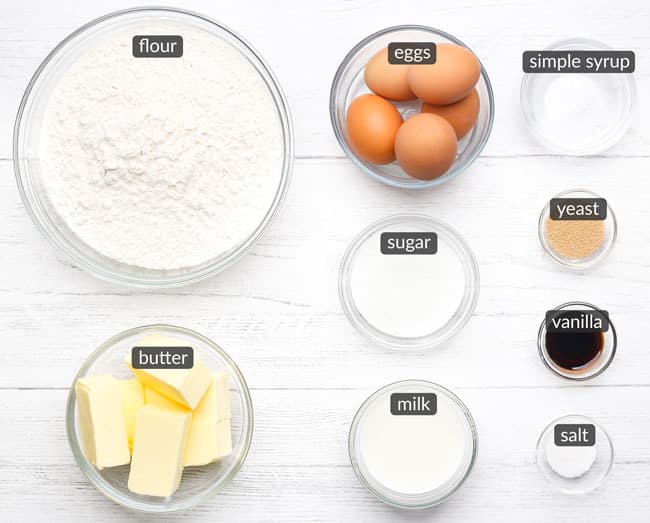
Ingredients
Click “Jump to the Recipe” at the top of the page or keep on scrolling to the recipe card for ingredient amounts and the full recipe instructions. Keep reading for substitutions, tips, and tricks. If you’re a bread baking beginner, read through the blog post before getting started.
- Milk – Any type you have on hand, even non-dairy alternatives.
- Yeast – I used dry active yeast. Instant yeast will work too.
- Sugar – Less for a more savory loaf, or more for a sweet loaf.
- Eggs – I used large eggs for this recipe.
- Vanilla – This is great for a sweet brioche. You can leave it out completely for a savory brioche.
- Flour – All-purpose. Bread flour will work too.
- Salt – As much or little as you like.
- Butter – Make sure to grab unsalted butter to give yourself full control over the sodium.
- Gloss – Simple syrup for sweet brioche, or an egg wash for savory brioche.
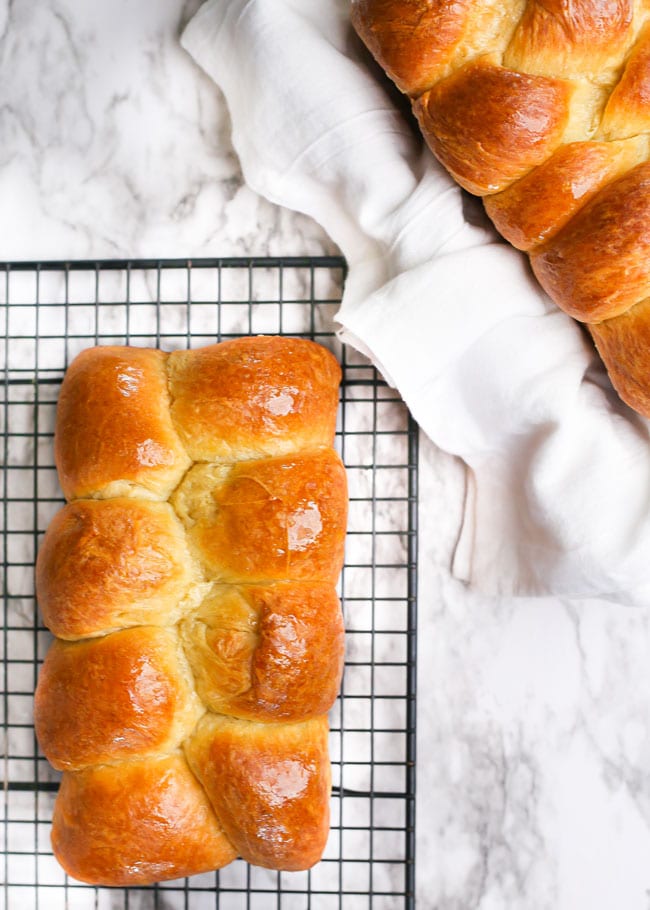
How to make homemade brioche
When planning this recipe, keep in mind it needs to rest overnight in the fridge. Give yourself two days to make this type of bread.
Day 1
- Whisk the lukewarm milk, yeast, and 1 tsp of the sugar together in the bowl of your stand mixer. Let the mixture sit for 5-10 minutes until it becomes foamy. Whisk in the eggs and vanilla extract.
- Mix the salt and remaining sugar into the flour. Add the dry ingredients into the bowl of your stand mixer. Secure the dough hook to the mixer, and mix on low speed until a shaggy dough forms.
- Add one piece of butter to the dough. Mix on medium speed until the butter is completely blended into the dough, about 2 minutes. Scrape down the sides of the bowl. Repeat this step until all the butter is completely incorporated into the dough.
- Continue to knead the dough on medium speed for 5-10 minutes, or until it’s completely smooth and elastic. The dough will be soft and slightly tacky to the touch. It should pull from the sides of the bowl. It may still stick to the bottom a bit. Cover the bowl with plastic wrap and transfer it to the fridge overnight.
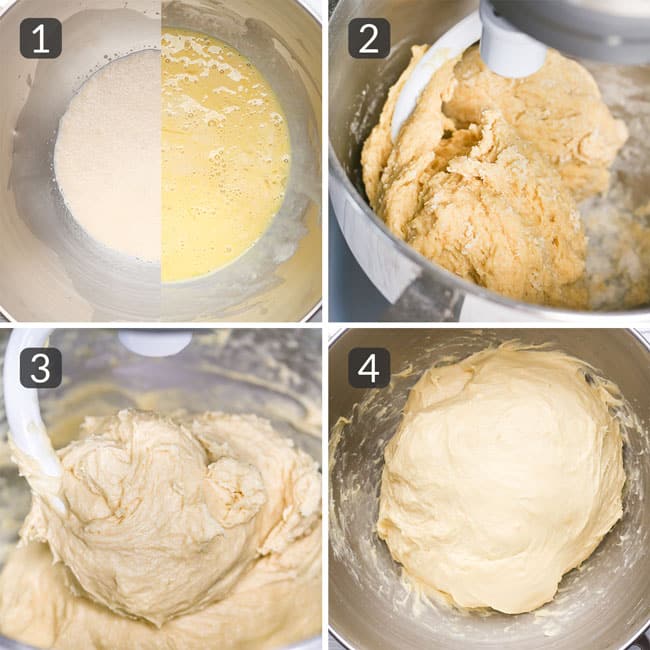
Day 2
- Remove the bowl from the fridge and let it sit at room temperature for 3 hours. Flour your work surface and hands well, Remove the dough from the bowl and form it into a ball.
- Split the ball into two equal-sized pieces. Set one of them aside and cover loosely with plastic wrap. Prep two loaf pans by generously buttering the inside, then dusting with flour.
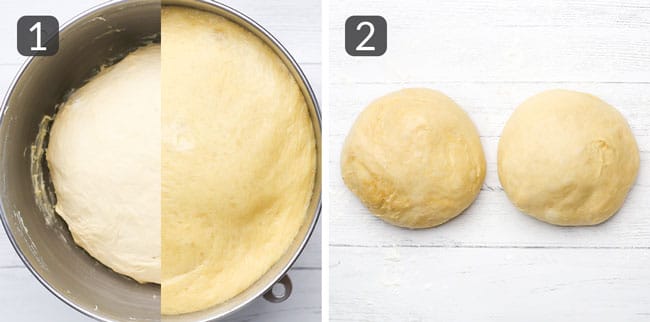
Braided loaf
- Roll the dough ball into a long, thin, oval-like shape. Use a knife or a pizza cutter to slice the oval into 3 equal-sized ropes, leaving about 1 inch of dough connecting the ropes at the top.
- Roll the ropes slightly to smooth them out. Starting from the top where the dough is still connected, braid the strands of dough. Once you’ve reached the end, pinch the ends of the ropes together.
- Gently lift the braid into one of the prepared loaf pans, tucking the inched ends underneath. Loosely cover the loaf pan with plastic wrap and set aside to rise for about 1 hour, or until doubled in size and reaching the top of the loaf pan.

Nantaise loaf
- Take the remaining dough ball and portion it into 8 equal-sized pieces. Flatten one of the pieces out, fold the edges into the middle, and pinch them together. Flip the piece over and cup your hand over it. Gently roll to create a perfect ball. Repeat with the remaining pieces of dough.
- Place the dough balls into the prepared loaf pan, slightly off-set to create a zig-zag pattern. Loosely cover the loaf pan with plastic wrap and set aside to rise for about 1 hour, or until doubled in size and reaching the top of the loaf pan.
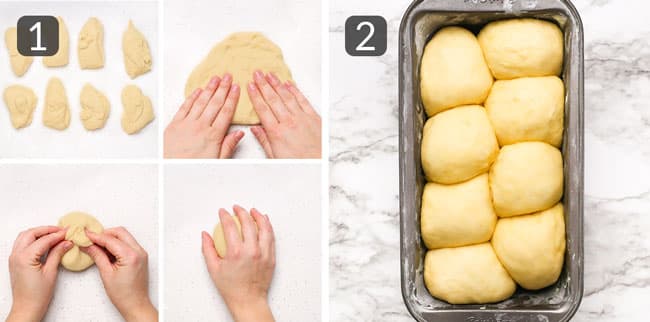
Bake
- While the loaves are rising, preheat the oven the 325F. Once the dough has risen, transfer the loaf pans to the oven and bake for 35-45 minutes, or until the tops are golden brown. *Optional: If you are making a savory brioche, brush the tops of the loaves with egg wash before baking.
- For the sweet brioche in the photos: Brush the loaves generously with syrup immediately once you take them out of the oven. Let the loaves cool for 10 minutes, then brush with another layer of syrup. Let the loaves sit for 5 minutes, then gently flip them out of the pan to finish cooling on a rack.
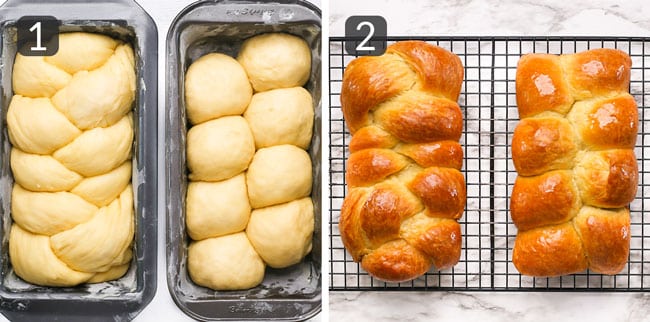
Troubleshooting your dough
Yeast
You need to make sure your yeast foams up in the first step. If it doesn’t, stop! Don’t continue with the recipe. This means your yeast was not activated properly and the dough will not rise. This could be because:
- The water wasn’t the right temperature. If it’s too cold, the yeast won’t be able to thrive. Water that’s too hot will kill the yeast. The water should be around 110F/45C; warm to the touch. Like baby formula.
- The yeast is dead. Remember: your yeast is a living organism. It can still die even within the expiry date.
- The yeast wasn’t stored properly. Make sure it’s in an airtight container. I like to buy jars of yeast since they have a tight screw top. Yeast will also last much longer stored in the freezer.
Dough
Your dough will only rise slightly overnight in the fridge. Once you take it out of the fridge to come to room temperature for 3 hours, it should rise significantly. If it isn’t rising, it could be because of these reasons:
- If you’re seeing some rising action, just be patient with it and give it time.
- The dough needs a warm, draft-free environment to rise. If it’s cold and/or drafty, the yeast will struggle to produce air bubbles. Try the inside of your oven, turned off, if your kitchen is too cold.
Okay! Now we know your dough will rise perfectly, without fail. What about the texture, though? Keep in mind this dough will feel tacky and a bit stickier than other doughs because of all the butter, but it shouldn’t be a complete mess sticking to your hands.
- It’s too sticky: Add 1 tbsp of flour at a time, until completely blended into the dough, until the right consistency is achieved.
- It’s too dry: Mix in a splash of milk or water at a time, until completely blended into the dough, until the right consistency is achieved.
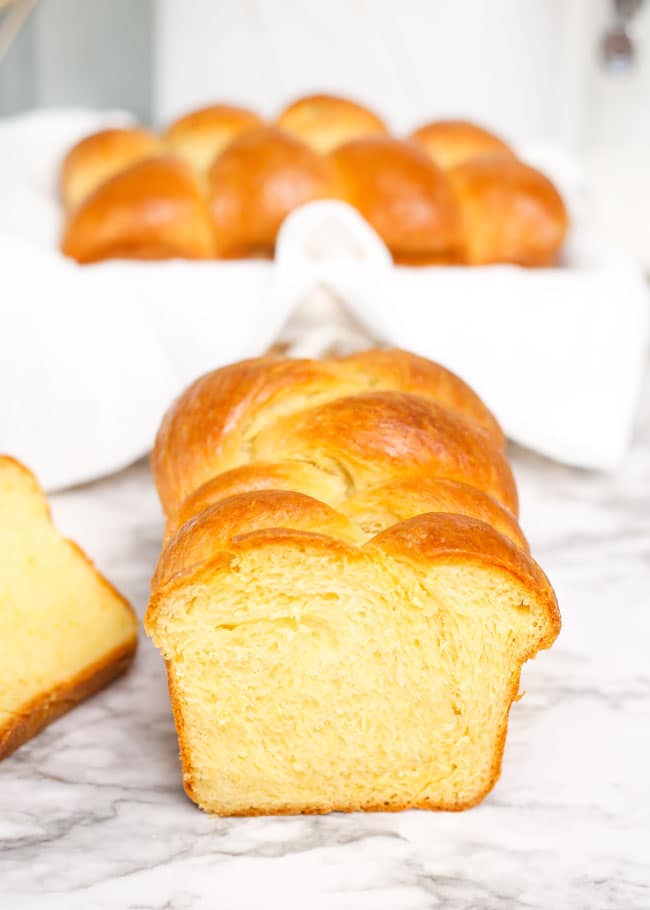
How to store homemade brioche
Your brioche will last about 1 day at room temperature or 2 days in the fridge. Wrap the bread well with plastic wrap or beeswax wrap. You can also keep it in an airtight container, or a cake plate with a dome.
Homemade bread, especially bread extremely soft like brioche, can dry out pretty easily. I suggest slicing it as you enjoy the loaf rather than pre-slicing it.
How to freeze homemade brioche
- Allow the loaves to cool completely to room temperature. Wrap them well with plastic wrap or beeswax wrap.
- Freeze for up to 2 months. Let the loaves thaw completely at room temperature before slicing.
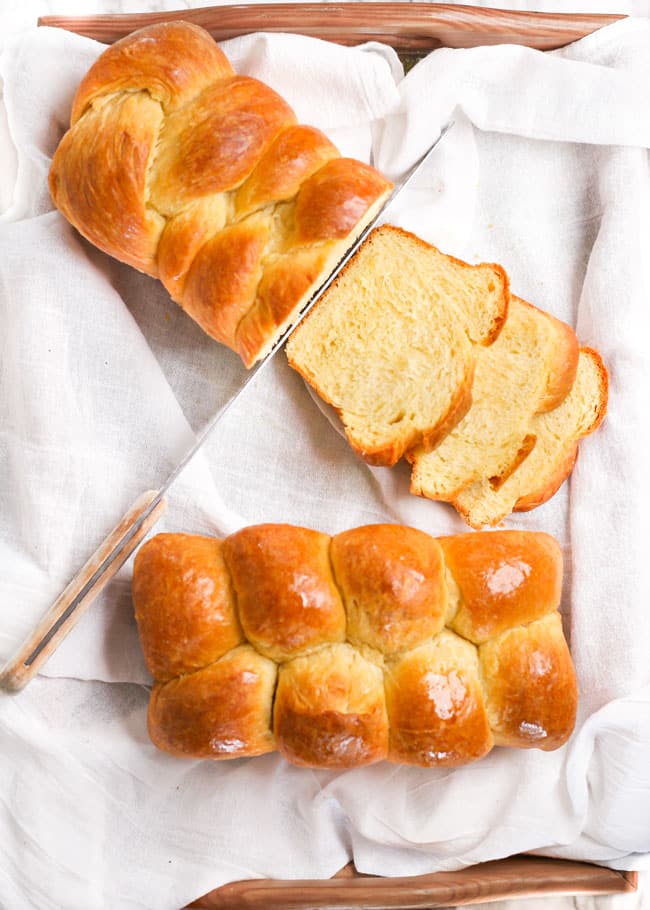
Check out these beautiful breads:
[ss_social_follow]
Homemade Brioche Recipe
Ingredients
- 1/2 cup milk lukewarm
- 1 tbsp active dry yeast
- 3-8* tbsp sugar use less for a savory brioche or more for a sweet brioche
- 5 large eggs room temperature
- 2 tsp vanilla extract optional, use if you're making a sweet brioche
- 4 1/2 cups flour all-purpose
- 1 1/2 tsp salt or to taste
- 1 1/4 cup butter unsalted, softened at room temperature, cut into 6 equal-sized pieces
- simple syrup or egg wash** for a glossy top, see recipe notes for details
Instructions
Day 1
- Whisk the lukewarm milk, yeast, and 1 tsp of the sugar together in the bowl of your stand mixer. Let the mixture sit for 5-10 minutes until it becomes foamy. Whisk in the eggs and vanilla extract.
- Mix the salt and remaining sugar into the flour. Add the dry ingredients into the bowl of your stand mixer. Secure the dough hook to the mixer, and mix on low speed until a shaggy dough forms.
- Add one piece of butter to the dough. Mix on medium speed until the butter is completely blended into the dough, about 2 minutes. Scrape down the sides of the bowl. Repeat this step until all the butter is completely incorporated into the dough.
- Continue to knead the dough on medium speed for 5-10 minutes, or until it's completely smooth and elastic. The dough will be soft and slightly tacky to the touch. It should pull from the sides of the bowl. It may still stick to the bottom a bit. Cover the bowl with plastic wrap and transfer it to the fridge overnight.
Day 2
- Remove the bowl from the fridge and let it sit at room temperature for 3 hours. Flour your work surface and hands well, Remove the dough from the bowl and form it into a ball.
- Split the ball into two equal-sized pieces. Set one of them aside and cover loosely with plastic wrap. Prep two loaf pans by generously buttering the inside, then dusting with flour.
Braided loaf
- Roll the dough ball into a long, thin, oval-like shape. Use a knife or a pizza cutter to slice the oval into 3 equal-sized ropes, leaving about 1 inch of dough connecting the ropes at the top.
- Roll the ropes slightly to smooth them out. Starting from the top where the dough is still connected, braid the strands of dough. Once you've reached the end, pinch the ends of the ropes together.
- Gently lift the braid into one of the prepared loaf pans, tucking the inched ends underneath. Loosely cover the loaf pan with plastic wrap and set aside to rise for about 1 hour, or until doubled in size and reaching the top of the loaf pan.
Nantaise loaf
- Take the remaining dough ball and portion it into 8 equal-sized pieces. Flatten one of the pieces out, fold the edges into the middle, and pinch them together. Flip the piece over and cup your hand over it. Gently roll to create a perfect ball. Repeat with the remaining pieces of dough.
- Place the dough balls into the prepared loaf pan, slightly off-set to create a zig-zag pattern. Loosely cover the loaf pan with plastic wrap and set aside to rise for about 1 hour, or until doubled in size and reaching the top of the loaf pan.
Bake
- While the loaves are rising, preheat the oven the 325F. Once the dough has risen, transfer the loaf pans to the oven and bake for 35-45 minutes, or until the tops are golden brown. *Optional: If you are making a savory brioche, brush the tops of the loaves with egg wash before baking.
- For the sweet brioche in the photos: Brush the loaves generously with syrup immediately once you take them out of the oven. Let the loaves cool for 10 minutes, then brush with another layer of syrup. Let the loaves sit for 5 minutes, then gently flip them out of the pan to finish cooling on a rack.
Notes
- Egg wash: whisk 2 eggs with 2 tbsp milk to water. After the dough has risen in the loaf pans, before transferring into the oven, gently brush the egg wash over the dough.
- Simple syrup: Dissolve 1/2 cup granulated sugar into 1/2 cup hot water. Let the syrup cool in the fridge as the loaves bake. Brush the loaves generously with syrup immediately once you take them out of the oven. Let the loaves cool for 10 minutes, then brush with another layer of syrup.

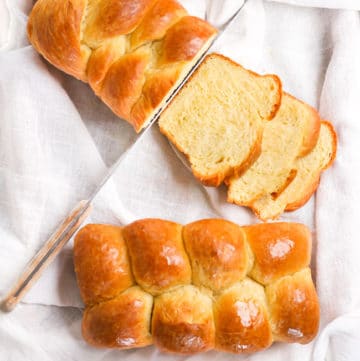
Easiest brioche recipe I found and still SO GOOD.
So easy and delicious
This is easy & delicious.
Anyone can do it! Glad you love the recipe 🙂